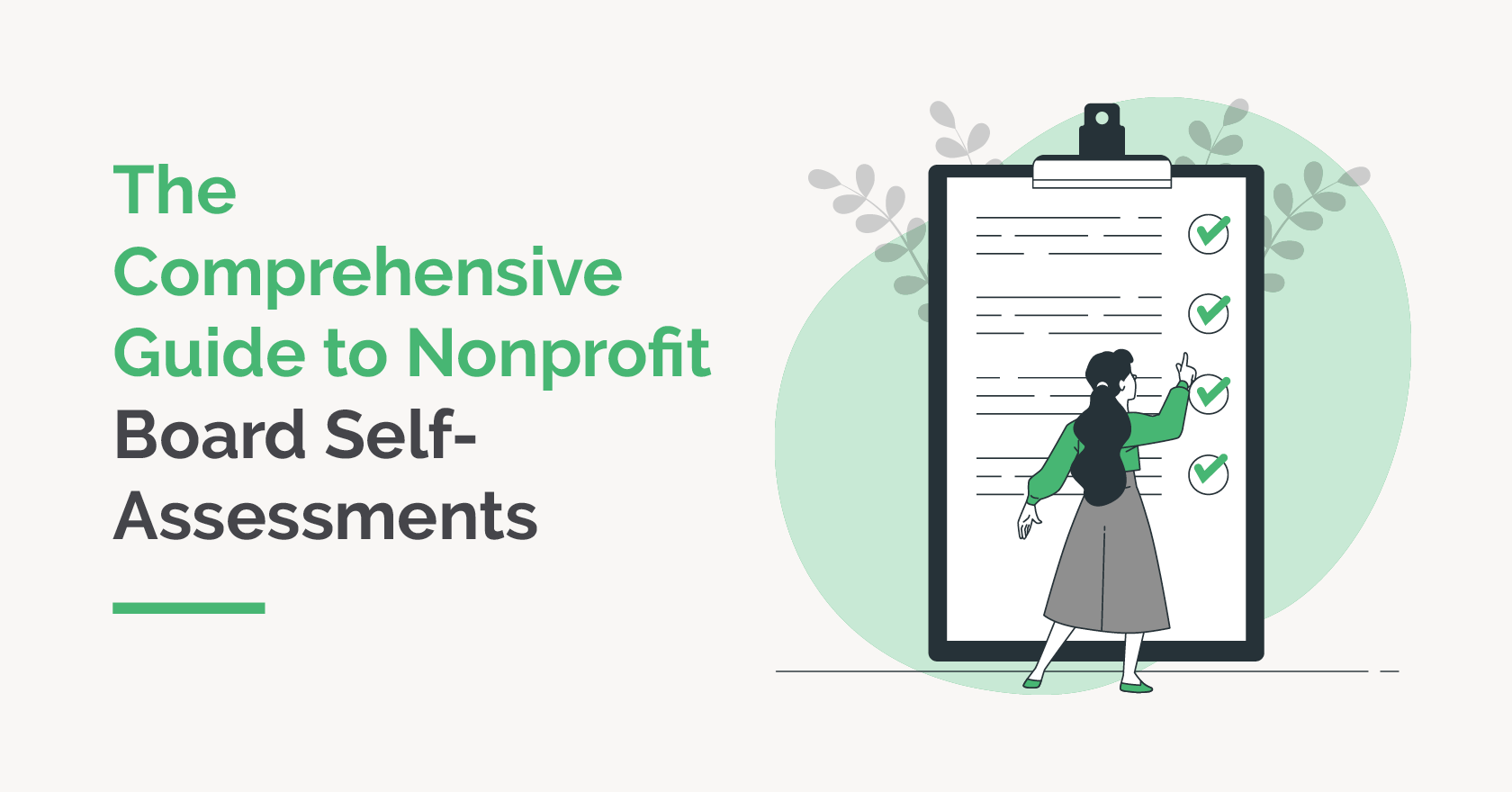

Board members play an important role in nonprofits. They have many responsibilities, ranging from governing their organizations to establishing new revenue streams to engaging the community.
Like any other governing body, it’s important for your board to occasionally take the time to reflect on its actions, assessing where individual board members and the board as a whole can improve. That’s where self-assessment comes in.
This guide will go over everything you need to know about nonprofit board self-assessment, covering the following topics:
Even the best nonprofits need check-ups to ensure that they can continue to thrive. Nonprofit board self-assessment allows you to implement practices and strategies for a healthy and engaged board, creating a more efficient and effective team dedicated to your organization’s success. So let’s jump in with the first topic: What is a nonprofit board self-assessment?

Nonprofit board self-assessments are fairly self-explanatory: You ask each board member to reflect on their tenure as a board member. During the assessment, they may consider if they’re following your nonprofit’s bylaws, meeting expectations as an individual and as a group, and making progress toward goals. Plus, they’ll have the opportunity to give feedback on the board’s health and practices.
Formal nonprofit board self-assessments usually take place annually or every few years. However, you can conduct self-assessments more frequently and informally to ease the pressure on board members. For example, you might ask your board to give quick feedback on what’s working and what could be improved in their processes at the end of each board meeting.
With 56% of nonprofits struggling with board governance, you must implement systems to check in on your board’s health. Self-assessments are a great way to do so—ultimately, they allow board members to improve as individuals and as a team.
By conducting a nonprofit board self-assessment, you can:
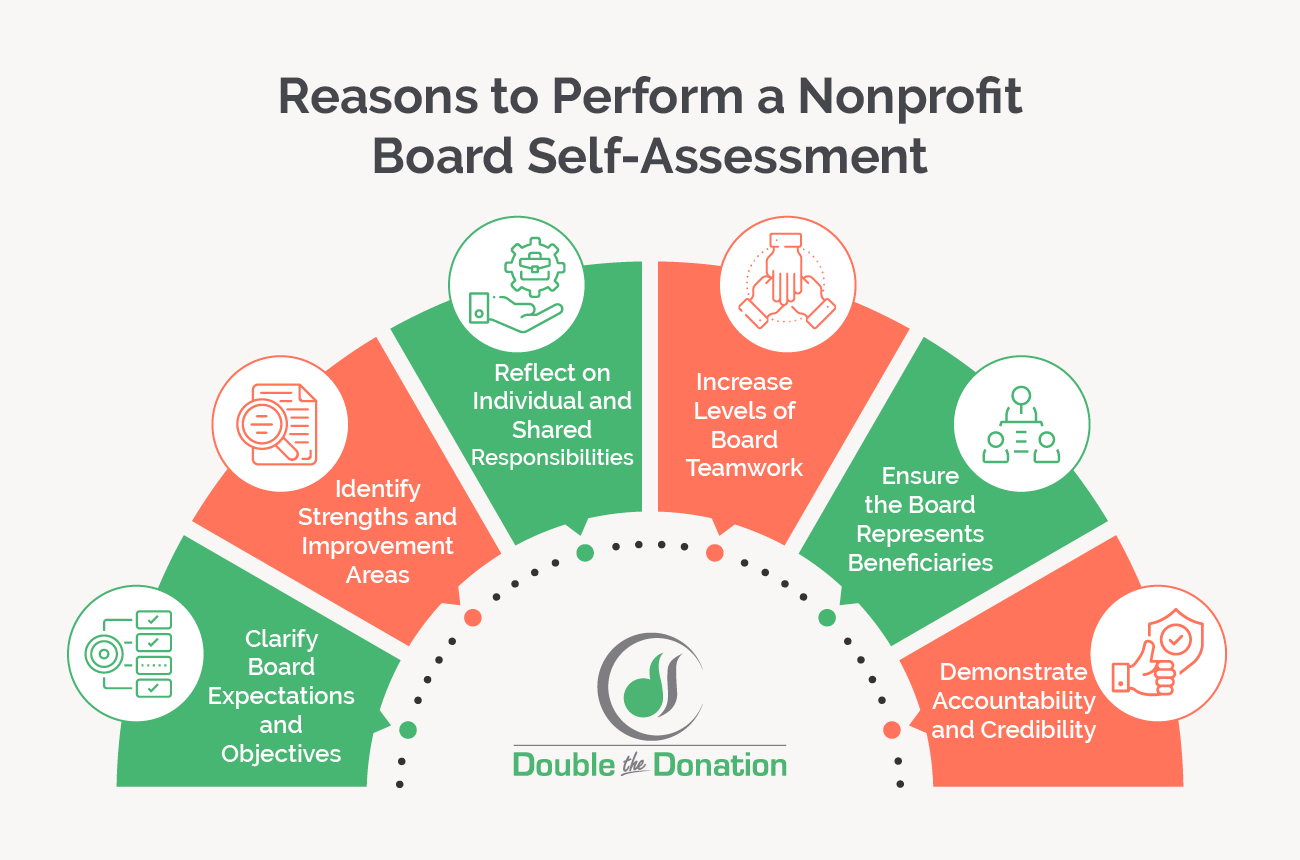
The self-assessment isn’t only about how the board members are serving your nonprofit. It’s also about how enjoyable their experience is. Through your assessment, verify that board members feel included, valued, and engaged with their work. Board members who are happy with their experience and responsibilities will be more likely to work harder to support your nonprofit through fundraising, advocacy, or other activities.
Now that you know what a nonprofit board self-assessment is and why you should conduct one, let’s go over the steps to a successful self-assessment.
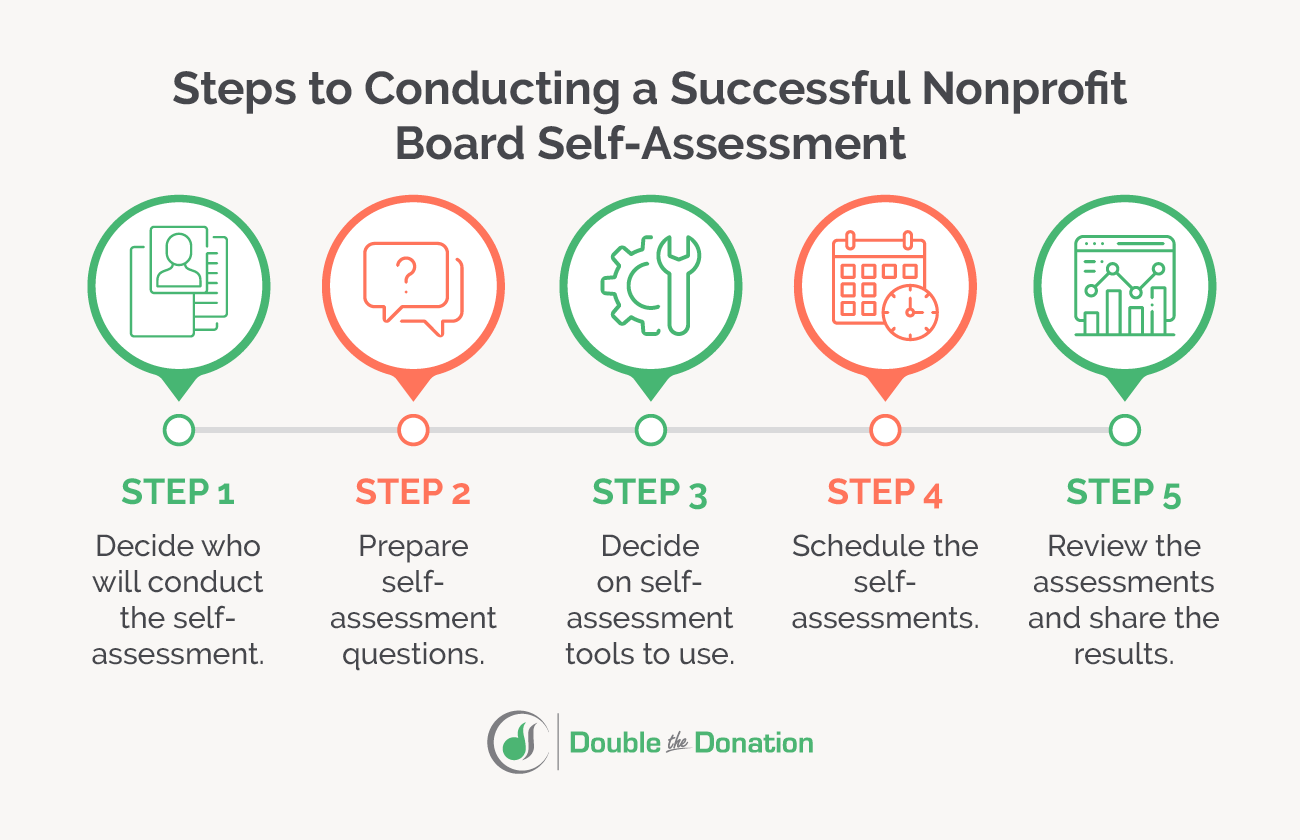
Although board members will complete the assessments, you’ll need to designate an individual to proctor or facilitate the assessments. This individual could be your nonprofit’s:
This individual will organize the assessment. After it is complete, they’ll moderate a board meeting where board members will discuss the results of the assessment. The proctor may not have access to the responses, but they’ll encourage board members to speak their minds and facilitate their growth during the conversation.
No one knows the work of your board members better than themselves, so have them come up with their self-assessment questions. They’ll need to determine what topics they need to assess, including their current work and the potential challenges in the coming years.
A good place to start is the general areas of board operations. These include:
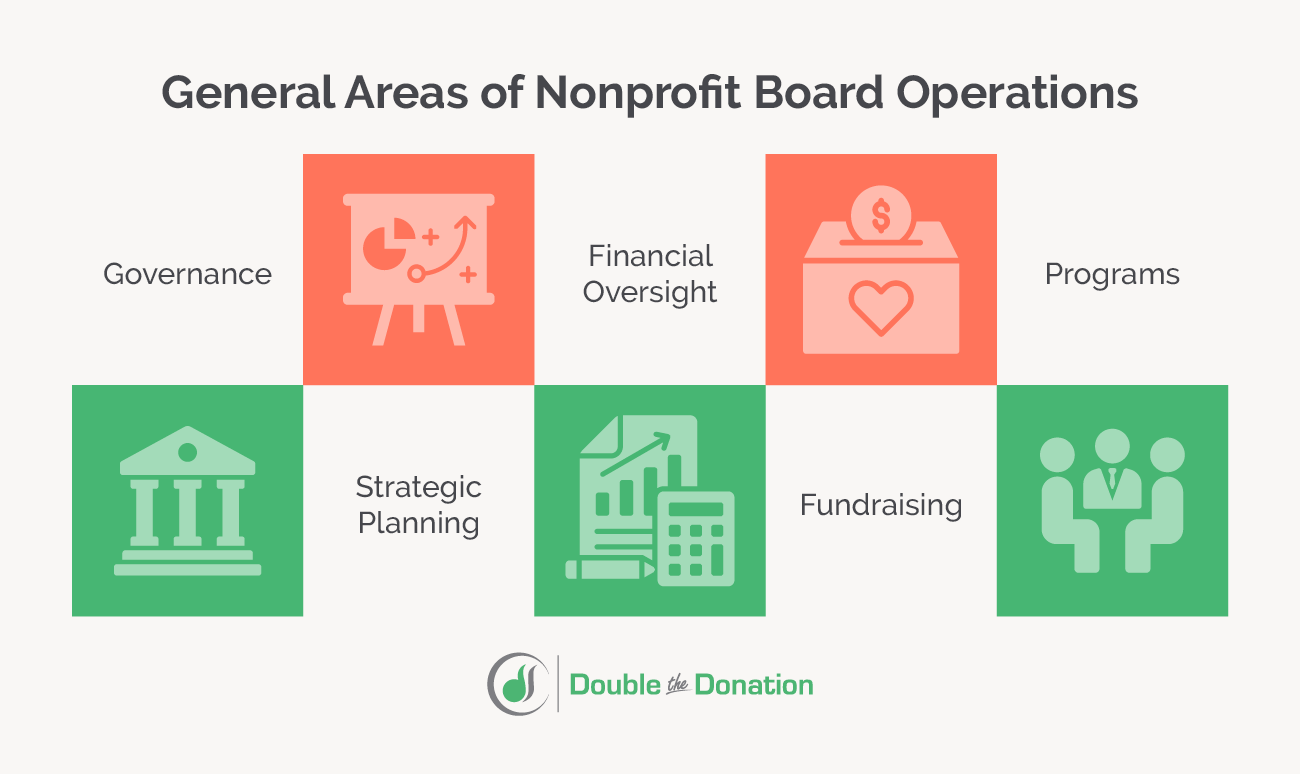 touch on in your nonprofit board self-assessment, also detailed in the text below." width="600" height="357" />
touch on in your nonprofit board self-assessment, also detailed in the text below." width="600" height="357" />
Additionally, include questions about the experience of serving on the board. You may have questions about how their experience has been so far, what they would change, and if there are any responsibilities or tasks they’d like to take on.
If you need more guidance on where to start, there are plenty of board self-assessment questionnaire templates that you can find. For example, BoardSource offers a free example of a self-assessment that you can reference.

Having board members fill out and complete self-assessments with pen and paper is a great starting point, especially if your board meets in person. However, if your board meets virtually or if you’re looking for a more elegant solution that makes evaluating the assessments easier, you might look into self-assessment tools.
Common tools you might consider include:
Don’t rush into purchasing technology. First, ensure the tool addresses an obstacle or a need for your nonprofit’s self-assessments. Then, carefully research the available tools and determine which one best fits your needs before making your decision.
After you’ve done all the preparation to ensure a smooth process, it’s time to schedule and complete the board self-assessments. Ideally, you’ll set time aside during your next meeting to avoid requiring more time from your busy board members. Depending on the length and depth of your assessment questionnaire, board members may need the entire meeting duration to complete their assessments.
If you’re not able to dedicate board meeting time to your self-assessment, then you’ll need to ask members to complete it on their own time. If this is the route you take, be sure to give board members ample time and set a reasonable deadline. For example, if you want the assessment to be done by the end of March, send out all the relevant materials and information by the end of February.
After the self-assessments are complete, it’s time to review the assessments and share the results. Here are a few ways you can conduct this process:
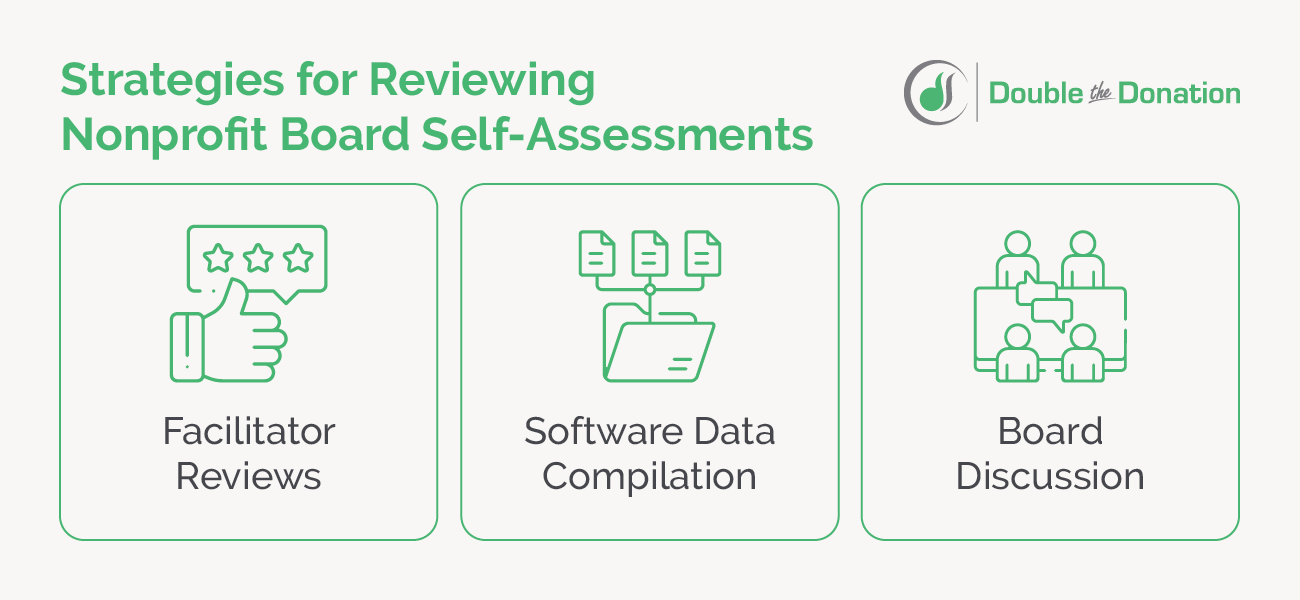
Keep in mind that since these are nonprofit board self-assessments, there’s some expectation of confidentiality. Regardless of which option you choose, uphold that principle. For example, if the facilitator of the assessment reviews each response, they should not mention what a specific board member wrote down. Instead, when discussing an insight with the board, they should simply say that one or more board members provided the response.
Now that you know how to conduct your board’s self-assessment, let’s go over the best practices to ensure that your nonprofit board remains engaged and dedicated to your organization’s success.
Regular nonprofit board self-assessments allow you to stay updated on the state of your board, including their engagement levels and satisfaction with their roles. Depending on your board terms, you can conduct assessments:
With regular check-ins, you’ll stay abreast of any important improvements to make, whether they’re for your nonprofit’s general governance or the satisfaction of an individual member. For example, if your board treasurer has been struggling to balance their nonprofit duties with their other responsibilities, you’ll be able to identify that early and help them either move into a less involved role or brainstorm another solution.
Since self-assessments are individual by nature, it’s easy for facilitators and nonprofit boards to get bogged down about individual responses and overlook examining the board as a whole. However, you must not miss the forest for the trees. It’s as important to evaluate your nonprofit board’s general competency as well as the competency of individual board members.
For example, let’s say that after examining the results of your last nonprofit board self-assessment, the assessment facilitator determines that a few board members have a poor understanding of their responsibilities. This may indicate that these board members got confused along the way and may simply need a refresher on what board governance entails.
However, the facilitator may ask, “Why have none of these board members sought help from other members? Why have none of the other members addressed these misunderstandings?” Depending on the answer to these questions, perhaps you only need to realign the initial group of board members with your nonprofit’s expectations. Or perhaps you need to put in place better strategies for creating a more welcoming, inclusive, and helpful board to encourage greater collaboration between members.
Maya Angelou once said, “I have great respect for the past. If you don’t know where you’ve come from, you don’t know where you’re going.” The same principle applies to your nonprofit—without reflecting on the past, you won’t know how to improve and grow in the future.
Your self-assessment should contain questions about your nonprofit’s past and future. You might include the following:
With questions such as these, you directly encourage board members to reflect on the past and apply those principles to your nonprofit’s future. This allows you to improve your nonprofit’s operations for the future, ensuring that you create the positive impact on your beneficiaries that you desire.
A common struggle for nonprofit board members is being involved in fundraising—beyond making donations themselves, board members may lack initiative when it comes to helping increase funding for their nonprofit.
That’s where corporate philanthropy comes in, specifically matching gifts. If you’re unable to engage board members with fundraising, you can at least maximize the donations they make to your organization.
This is how matching gifts with board members works:
As companies usually match donations at a 1:1 ratio, this allows you to essentially double the donation you receive from your board member. And some organizations are particularly generous to nonprofit board members.
Plus, once you educate board members about this unique corporate giving initiative, they may be happy to spread the word about it on your behalf. With over $4 billion in matching gifts going unclaimed every year, the extra awareness could be invaluable for increasing revenue for your organization.
All governing bodies, regardless of whether they belong to for-profit or nonprofit organizations, require strategies for accountability, improvement, and growth. Nonprofit board self-assessments are one such strategy. With thorough research and preparation, you’ll be able to facilitate assessments and discussions afterward that move your board and nonprofit as a whole forward.
If you’re looking for more information about nonprofit boards and fundraising, check out these resources:

https://doublethedonation.com/wp-content/uploads/2024/03/Nonprofit-Board-Self-Assessment_Feature.png 880 1680 Adam Weinger https://doublethedonation.com/wp-content/uploads/2022/03/logo-dtd.svg Adam Weinger 2024-03-05 13:13:14 2024-03-05 13:30:20 The Comprehensive Guide to Nonprofit Board Self-Assessments

A B C D E F G H I J K L M N O P Q R S T U V W X Y Z
Most Popular Terms: